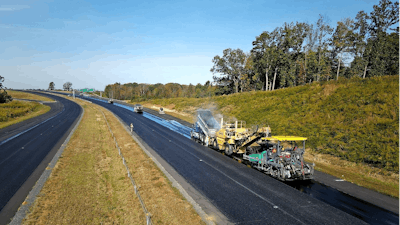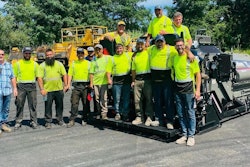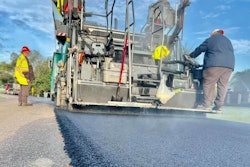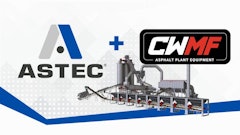
Four years is not a lot of time when you're tasked with constructing 14.4 miles of roadway. Add in six interchanges, seven grade crossings and 24 bridges, and you're really asking for a miracle. And that's exactly what Asheboro Bypass Constructors pulled off in North Carolina.
This project actually started back in 2011 when the team at Thompson-Arthur APAC Atlantic, a CRH Company, teamed up with the Wright Brothers. They knew the North Carolina Department of Transportation (NCDOT) was planning to improve U.S. 64 in the Asheboro area. The proposed project was a new 14.4-mile freeway bypassing Asheboro to the south.
The project also featured a highly-anticipated 1.8 mile Zoo Connector, which would give visitor to the massively popular North Carolina Zoo better access to the park from the U.S. 64 Bypass straight to the zoo's entrance via a roundabout, instead of through residential areas.
Thompson-Arthur and Wright Brothers teamed up with RK&K to design engineer the project and Right-of-Way Consultants to work with appraisals and acquisitions. The four companies made up the design-build team, Asheboro Bypass Constructors, LLC (ABC). Using a design-build process allowed NCDOT to contract with the team of designers and contractors who would be responsible for the design, right of way acquisition and construction of a project.
The project was awarded to this team in 2015 and construction began in 2016. Completed in December of 2020, the North Carolina Department of Transportation’s Asheboro Bypass was the most complex design-build project APAC-Atlantic, Inc., Thompson-Arthur Division, had ever undertaken. The design-build team worked together constructing the 14.4-mile, four-lane, divided highway from US 64 west of Asheboro, through the rolling and rocky hills to the south, and back to US 64 in the east. Here's how it happened.
Acquisition & Relocation
A project of this size requires massive amounts of planning and the Thompson-Arthur team relied heavily on the team at Right-of-Way Consultants to start everything off right. Right of Way is one of North Carolina's most experienced right-of-way firms and they had 40 staff members committed to this project.
"The biggest thing at the beginning was the right away acquisition," Jeff W. Saunders, construction projects manager at Thompson-Arthur says. "We needed to complete all of the utility relocation was being coordinated before we could start work."
ABC had to handle the complexity of connecting to, or crossing through, 17 different existing roadways, each with its distinct utility relocations and traffic control management. Compounding those challenges was the overall acquisition of 460 parcels for right-of-way and impacts to 103 locations on permitted jurisdictional streams.
To get started, the project team strategically focused the land acquisition and utility relocation in areas of important reinforced concrete box culverts and bridges that would provide early access to areas of mass grading. The sequence of land acquisition, utility relocation and construction was used repeatedly for the first two years before the entire footprint of the project finally took shape.
The ABC team had to wait until the right of way was acquired and worked to streamline areas where they wanted to begin the heavy excavating and mainline work.
"We did a good job of identifying areas that we could get access to so we were able to get some of the mainline areas started," Saunders said. "We focused on prioritizing those specific right away parcels so we could get to work excavating and grading as quickly as possible."
Excavation & Grading
Thompson-Arthur partnered with Wright Brothers for the excavation and grading portion as they are the Southeastern U.S. leader in mass excavation with the extensive heavy equipment and resources that were needed to complete the project.
"Thompson-Arthur is paving and bridges and Wright Brothers completes excavation and bridges," Larry Brickey, division president at Thompson-Arthur says "Wright Brothers did all the grading, we did all the paving and stone base work and we split the bridge work in half."
And it's a good thing Wright Brothers specializes in excavation with as there were over 500 acres to clear. They removed 8 million cubic yards of earth excavation and 2.75 million cubic yards of just rock excavation.
Communication during this process was key to success as the movement of material had to be done in an efficient manner and the ABC team worked diligently to keep each of the three separate sections, five miles long each, progressing on schedule.
"We had a very good schedule and a very good sequence operations," Brickey says. "We worked on a two month schedule and Michael Prince, who he was the onsite manager for Wright Brothers, did a very good job at managing that."
Wright Brothers put a project schedule together pre-bid using the Primavera project scheduler. That allowed the project to continually progress in parts along each section, even as the job was spread out over the 14 miles.
"Wright Brothers did a very good job and knowing where the material was and where it had to go," Brickey adds. "One of the first cuts on the West End the job was a 60 foot cut which was was pretty much rock the whole way. They would get that cut, get that fill in, get working on a bridge, complete the underground as well all the storm drain. And once that was done, we'd be in there paving."
To help streamline the construction schedule and provide a consistent pavement subgrade throughout the length of the project, the ABC Team elected to use 8-in. of aggregate base course in conjunction with geotextile stabilization fabric instead of choosing chemical subgrade stabilization. This process removed the need for repetitive and continuous soil sampling and testing, as well as the seasonal limitations for placing chemical stabilization, which thereby extended the allowable time for pavement construction.
Chemical stabilization would have switched back and forth from cement stabilization to lime stabilization depending on the many soil types that were encountered along the 14 miles of roadway. Overall, using aggregate base simplified the process of pavement construction.
Asphalt Paving
The Thompson-Arthur team are experts in asphalt production and paving. They utilized their asphalt plant locations to make the mix for the project.The mix selection was chosen by the NCDOT, a B25-I19, CS 9-1/2-inch in base, binder surface laydown pattern.
To enhance the safety of the project, specifically during rain events, the team added an asphalt pavement layer to US 64 throughout the project limits. This open-graded friction course asphalt layer has become more prevalent on high-volume, high-speed facilities to proactively combat hydroplaning. This open-graded friction course is a permeable asphalt layer that will allow water on the surface to drain vertically through the layer instead of draining naturally off the roadway. As a result, during rainfall there is an increase in surface drainage, limiting the potential for hydroplaning, and driver visibility due to noticeable reductions in water spray behind vehicles.
In all, Thompson-Arthur team members put down 745,000 tons of asphalt from their plant locations. They utilized Weiler material transfer vehicles to keep the flow of material moving to their VOGELE pavers. HAMM rollers were onsite to assist with compaction.
In all, over 200 employees were working on this jobsite at peak times.
The total price tag for the project, including construction costs, design, right of way acquisition, utility relocation consulting costs, plan revisions and numerous additions, added up to roughly $264 million. Ultimately, nearly four years and approximately 1,360,029 man-hours later, Asheboro Bypass Constructors delivered the design-build project on schedule, with one lost time incident, while providing more than $1.4 million in value engineering.




















